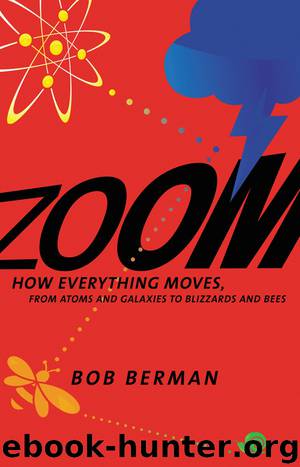Zoom: From Atoms and Galaxies to Blizzards and Bees: How Everything Moves by Bob Berman

Author:Bob Berman [Berman, Bob]
Language: eng
Format: epub
Tags: Science, General, Physics, Geophysics, Optics & Light, Essays, Science / Essays, Science / General, Science / Physics / General, Science / Physics / Geophysics, Science / Physics / Optics & Light
ISBN: 9780316217422
Google: AFc-nwEACAAJ
Publisher: Little, Brown
Published: 2014-06-23T18:30:00+00:00
CHAPTER 12: Brooks and Breakers
Earth’s Greatest Assets Are Liquid
But ol’ man river,
He jes’ keeps rollin’ along.
—OSCAR HAMMERSTEIN II, “OL’ MAN RIVER” (1927)
The headline was grim.
FIFTY-FOUR MIGRANTS DIE OF THIRST IN MEDITERRANEAN BOAT DRAMA.
Datelined Geneva, July 11, 2012, it recounted a horrific ordeal. Nearly five dozen migrants from Africa trying to reach Italy died of thirst when their inflatable boat ruptured in the Mediterranean, according to testimony from the sole survivor, Abbes Settou. The UN refugee agency UNHCR said that Settou, who drank seawater to survive, was spotted clinging to the remains of the stricken boat off the Tunisian coast by fishermen who alerted the coast guard. The man said there was no fresh water on board and people started to perish within days, including three members of his family.
It’s the cruelest irony to die of thirst while immersed in water.
It also highlights water’s critical importance. Of all the moving entities that surround and permeate our lives, the most vital are water and air—curiously, the only essentials that are transparent.
Our bodies are two-thirds water. Our brains are mostly made of it. No wonder these same brains enjoy watching it move as we dreamily stare at rivers and marvel at waterfalls. We bathe in water and jump into it at the slightest provocation; it’s the centerpiece around which vacations revolve. And, as with everything on this yin-yang planet, it sometimes turns on us, as my niece and Abbes Settou, sadly, learned.
Walls of water have always been terrifying. Yet aquatic fact and fiction competitively marched side by side for countless centuries. It took until passable science knowledge arrived in the nineteenth century before Noah’s flood went from literal truth to mere parable. This happened only when it became obvious that if every ounce of water vapor in the atmosphere precipitated as rain, it would raise the sea level by only a single inch. No need for an ark. Noah’s forty days of rain notwithstanding, floods, then as now, can never be more than regional events.
Still, the connection between water and humans may be even deeper than we suspect. Though generally ignored by anthropologists, the theory that Homo sapiens may be an aquatic ape linked genetically with lakes or the sea may explain such puzzles as our relative hairlessness, the size of our noses, and why we, unlike other primates, gasp when startled.1
In any event, Earth’s existence as a water planet, where 70 percent of the surface is liquid to an average depth of twelve thousand feet, is unique in the solar system. But it’s also logical, because H2O is the most common compound in the cosmos.
This, too, makes perfect sense. The universe’s most abundant elements are hydrogen, helium, and oxygen. Helium doesn’t combine with anything, so cross that off the “most important” list. And even though oxygen is a thousand times less prevalent than hydrogen, it’s always eager to join the party—any party. Small wonder that the H-and-O courtship and perennial “exchange of rings” is repeated in every corner of space and time.
Telescopes show water virtually everywhere.
Download
This site does not store any files on its server. We only index and link to content provided by other sites. Please contact the content providers to delete copyright contents if any and email us, we'll remove relevant links or contents immediately.
Man-made Catastrophes and Risk Information Concealment by Dmitry Chernov & Didier Sornette(4731)
The Revenge of Geography: What the Map Tells Us About Coming Conflicts and the Battle Against Fate by Kaplan Robert D(3596)
Zero Waste Home by Bea Johnson(3286)
COSMOS by Carl Sagan(2944)
In a Sunburned Country by Bill Bryson(2942)
Good by S. Walden(2910)
The Fate of Rome: Climate, Disease, and the End of an Empire (The Princeton History of the Ancient World) by Kyle Harper(2431)
Camino Island by John Grisham(2380)
A Wilder Time by William E. Glassley(2358)
Organic Mushroom Farming and Mycoremediation by Tradd Cotter(2304)
Human Dynamics Research in Smart and Connected Communities by Shih-Lung Shaw & Daniel Sui(2175)
The Ogre by Doug Scott(2105)
Energy Myths and Realities by Vaclav Smil(2054)
The Traveler's Gift by Andy Andrews(2008)
Inside the Middle East by Avi Melamed(1937)
Birds of New Guinea by Pratt Thane K.; Beehler Bruce M.; Anderton John C(1905)
Ultimate Navigation Manual by Lyle Brotherton(1764)
A History of Warfare by John Keegan(1712)
And the Band Played On by Randy Shilts(1612)
